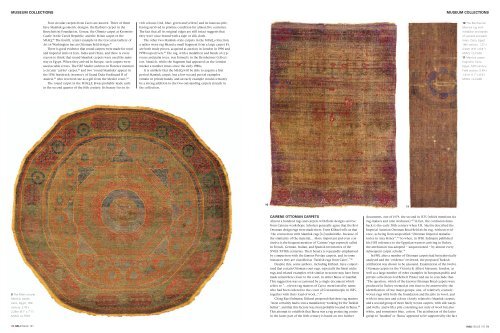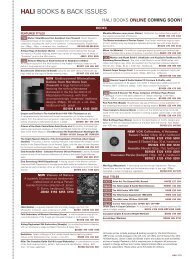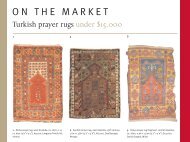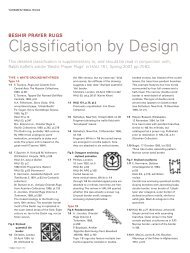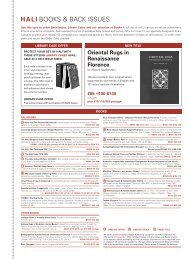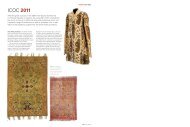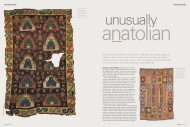2: IBERIAN & EAST MEDITERRANEAN CARPETS IN THE - Hali
2: IBERIAN & EAST MEDITERRANEAN CARPETS IN THE - Hali
2: IBERIAN & EAST MEDITERRANEAN CARPETS IN THE - Hali
Create successful ePaper yourself
Turn your PDF publications into a flip-book with our unique Google optimized e-Paper software.
MUSEUM COLLECTIONS<br />
9 The Milan circular<br />
Mamluk carpet,<br />
Cairo, Egypt, 16th<br />
century. 2.78 x<br />
2.26m (9'1" x 7'1").<br />
MIAQ, no.TE07<br />
78 HALI ISSUE 157<br />
Four circular carpets from Cairo are known. Three of them<br />
have Mamluk geometric designs: the Barbieri carpet in the<br />
Bruschettini Foundation, Genoa; the Olmutz carpet at Kremsier<br />
Castle in the Czech Republic; and the Milan carpet in the<br />
MIAQ. 80 The fourth, a later example in the Corcoran Gallery of<br />
Art in Washington has an Ottoman field design. 81<br />
There is good evidence that round carpets were made for royal<br />
and imperial tents in Iran, India and China, and there is every<br />
reason to think that round Mamluk carpets were used the same<br />
way in Egypt. When they arrived in Europe, such carpets were<br />
used as table covers. The 1587 Medici archives in Florence mention<br />
a circular ‘cairino’ carpet, 82 and two ‘round Mamluks’ appear in<br />
the 1596 Innsbruck inventory of Grand Duke Ferdinand II of<br />
Austria, 83 who received one as a gift from the Medici court. 84<br />
The round carpet in the MIAQ 7, 9 was probably made early<br />
in the second quarter of the 16th century. Its beauty lies in its<br />
rich colours (red, blue, green and yellow) and its lustrous pile,<br />
having survived in pristine condition for almost five centuries.<br />
The fact that all its original edges are still intact suggests that<br />
they were once bound with a tape or silk cloth.<br />
The other two Mamluk-style carpets in the MIAQ collection,<br />
a rather worn rug 10 and a small fragment from a large carpet 11,<br />
are both study pieces, acquired at auction in London in 1996 and<br />
1998 respectively. 85 The rug, with a medallion and bands of cypresses<br />
and palm trees, was formerly in the Bernheimer Collection,<br />
Munich, while the fragment had appeared on the London<br />
market a number times since the early 1980s.<br />
It is unlikely that the MIAQ will be able to acquire a first<br />
period Mamluk carpet, but a few second period examples<br />
remain in private hands, and an early example would certainly<br />
be a strong addition to the two outstanding carpets already in<br />
the collection.<br />
10<br />
CAIRENE OTTOMAN <strong>CARPETS</strong><br />
Almost a hundred rugs and carpets with floral designs survive<br />
from Cairene workshops. Scholars generally agree that the first<br />
Ottoman design rugs were made there. Ernst Kühnel tells us that<br />
“the connection with Mamluk rugs [is] undeniable, because of<br />
the similarity of the material... More important and even conclusive<br />
is the frequent mention of ‘Cairene’ rugs expressly called<br />
in French, German, Italian, and Spanish inventories of the<br />
XVIth-XVIIth centuries. Their beauty is repeatedly emphasised<br />
by comparison with the famous Persian carpets, and in some<br />
instances they are classified as ‘Turkish rugs from Cairo’.” 86<br />
Despite this, some authors, including Kühnel, have conjectured<br />
that certain Ottoman court rugs, especially the finest niche<br />
rugs and related examples with similar structure may have been<br />
made somewhere closer to the court, in either Bursa or Istanbul.<br />
This suggestion was occasioned by a single document which<br />
refers to “...eleven rug masters of Cairo, mentioned by name,<br />
who had been ordered to the court of Constantinople in 1585,<br />
together with their load of wool…”. 87<br />
Citing Kurt Erdmann, Kühnel proposed that these rug masters<br />
“most certainly had to run a manufactory working for the Turkish<br />
Sultan”, and that this factory was most probably located in Bursa. 88<br />
This attempt to establish that Bursa was a rug producing centre<br />
in the latter part of the 16th century is based on two further<br />
11<br />
documents, one of 1474, the second in 1525 (which mentions six<br />
rug-makers and nine workmen). 89 In fact, the confusion dates<br />
back to the early 20th century when F.R. Martin described the<br />
Imperial Austrian Ottoman floral field niche rug, without evidence,<br />
as being from unspecified “Ottoman Imperial manufactories<br />
in Asia Minor”. 90 So when, in 1938, Erdmann published<br />
his 1585 reference to the Egyptian weavers arriving in Turkey,<br />
the attribution was adopted – unquestioned – by almost every<br />
subsequent carpet scholar. 91<br />
In 1981, after a number of Ottoman carpets had been physically<br />
analysed and the ‘evidence’ reviewed, the proposed Turkish<br />
attribution was shown to be unsound. Examination of the twelve<br />
Ottoman carpets in the Victoria & Albert Museum, London, as<br />
well as a large number of other examples in European public and<br />
private collections led Robert Pinner and me to conclude that:<br />
“The question, which of the known Ottoman floral carpets were<br />
produced in Turkey seemed at one time to be answered by the<br />
identification of two major groups: one, of relatively coarselywoven<br />
rugs with both the foundation and the pile in wool, and<br />
with its structure and colour closely related to Mamluk carpets,<br />
and a second group of more finely woven carpets, with silk warps<br />
and wefts, and with a pile consisting not only of wool but also<br />
white, and sometimes blue, cotton. The attribution of the latter<br />
group to ‘Istanbul’ or ‘Bursa’ appeared to be supported by the fact<br />
MUSEUM COLLECTIONS<br />
10 The Bernheimer<br />
Mamluk rug with<br />
medallion and bands<br />
of cypress and palm<br />
trees. Cairo, Egypt,<br />
16th century. 1.37 x<br />
2.04m (4'6" x 6'8”).<br />
MIAQ, no.CA04.<br />
11 Mamluk carpet<br />
fragment. Cairo,<br />
Egypt, 16th century.<br />
Field section, 0.49 x<br />
1.91m (1'7" x 6'3").<br />
MIAQ, no.CA06.<br />
HALI ISSUE 157 79


